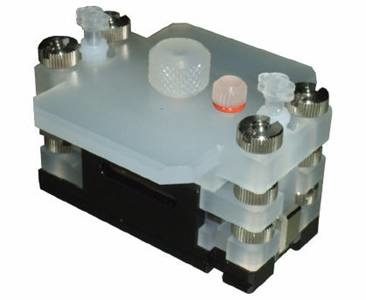A new application note announced today by Beckman Coulter, Inc. details the study of the isoelectric point of flat surfaces using the DelsaNano zeta potential system. The procedure, Determining the Isoelectric Point of a Flat Surface Using the DelsaNano, published in Beckman Coulter's Information Bulletin IB-15476A, enables the study of surface charge and changes in surface charge that result from coating, chemistry and fouling.
The DelsaNano is the only system available today to employ electrophoretic light scattering to assess surface charge. The light scattering approach offers several advantages over other technologies, including the ability to analyze smaller samples and precise isoelectric point determination.
 The flat-surface cell enables the Beckman Coulter, Inc. DelsaNano zeta potential system to be used in the study of the isoelectric point of flat surfaces. Image credit: Beckman Coulter
The flat-surface cell enables the Beckman Coulter, Inc. DelsaNano zeta potential system to be used in the study of the isoelectric point of flat surfaces. Image credit: Beckman Coulter
"Since releasing the flat-surface cell of the DelsaNano, through collaboration with our customers we have learned a tremendous amount about how to best apply the powerful surface zeta potential measurement," said Edgar Martinez, senior applications scientist and the procedure's lead author. "Since demand for tools to study surface zeta potential has increased rapidly, we decided to compile and publish best practices so that users can obtain the utmost in reliability, accuracy and precision for their applications."
The procedure can be used in research and development and manufacturing quality control, in applications such as thin-film deposition, biocompatible material development, wafer assembly and other fields in which the character and interaction of surfaces is critical. IB-15476A details experiment set-up, recommended reagents and sample types, example data and maintenance guidelines and is available through Beckman Coulter Particle Characterization representatives.